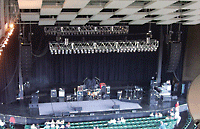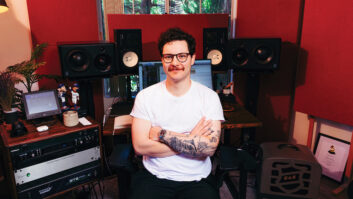
MBI Products‘ Lapendary Panels installed in DTE Energy Music Theatre’s
ceiling help reduce reflections. Also shown is the venue’s new EAW KF760/761 line array.
in the cold of winter, it warms my heart to think of outdoor summer gigs: bike rallies, outdoor festivals and, of course, sheds! One stop I have been making annually with Blue Öyster Cult for many years has been the DTE Energy Music Theatre in Clarkston, Mich. Formerly known as Pine Knob, the DTE Energy Music Theatre is “the outdoor summer stop” in the Detroit area for national acts. A shed-type amphitheater, the theater can hold 7,212 attendees seated under the roof and space for another 8,072 on the lawn area.
As Blue Öyster Cult rarely travels with production, I have always used DTE’s in-house P.A. The venue’s racks and stacks are augmented with a Yamaha PM4000 in addition to Yamaha, Roland, dbx, Drawmer and Aphex processing furnished by West River Light and Sound in Sanford, Mich. No question it was a pro rig (flown EAW KF750 cabinets) but I always felt like I was in that scene from Star Wars in which Han Solo tries to make the jump to lightspeed in the Millennium Falcon: I’d hit the gas but not much would happen. It seemed like I was always pushing the amps to the max, especially in the bottom end. (Maybe the venue was trying to tell me to keep the SPL down!) During the summer of 2004, I returned to DTE with BÖC and was delighted to find that DTE Energy Music Theatre’s VP of venue production, Mike St. Peter, had completed a new install. The differences were anything but subtle.
St. Peter’s tenure as the venue’s chief engineer goes back 16 years when it was Pine Knob. He explains that when Palace Sports & Entertainment took over the venue, it was “just a shell with a lot of hard surfaces and a bit of boominess. We softened things up, starting with the stage house, by placing Sonex on the side and back walls all the way [45 feet] to the ceiling. We also installed heavier curtains. The structure is what they call a ‘stick building,’ with 2×6 studs on 16-inch centers across the back. We were able to cut the Sonex, place it within the 2×6s and cover it with material so you can’t see it. To eliminate any possibility of vibration-induced noise, the stage-left and stage-right wings were isolated from any hard structure and half-inch rubber was used for the surface of the wings.
“Initially, our goal was getting the stage volume under control. As a front-of-house engineer,” St. Peter tells me, “I appreciate that you need to get monitor levels down to where you can’t hear the monitors out front. By softening the stage, the monitor engineer can get the stage volume needed to make the band happy, without creating all the reflections that muddy the front-of house mix. Those changes helped tremendously and gave the front-of-house engineer more control over the mix. From there, we started a progression of fine-tuning, such as softening the surfaces within 25 feet of the speaker arrays to help reduce early reflections. My mentors were Don and Carolyn Davis [founders of Syn-Aud-Con], who were very big on dealing with the effects of early reflections and anything that transmits unwanted noise into the listening area. I tried to incorporate many of their ideas into the building.”

Mike St. Peter, DTE’s VP of venue production
Keeping monitor spill out of the house was a great help to FOH engineers — including myself — but there were still plenty of reflective surfaces to address, including the venue’s ceiling. “We wanted to do the same thing with the ceiling,” continues St. Peter, “so we got MBI Products [Cleveland] involved and decided to use their Lapendary Panels to treat the ceiling. These are 4-foot-wide panels with a perforated surface baffle and a glass-fiber interior. Those were hung from the ceiling, but they weren’t placed directly against the ceiling — there is a space of roughly 18 inches between the ceiling and the panels. Any sound that passes through the panel hits the ceiling and has to again pass through the panel before reaching the listener, which helps reduce ceiling reflections even further. Those panels gave us fairly broad [band] absorption, but really helped the 600Hz boom in the venue. It also made the room more pleasing, with increased directionality from the speakers. Now, you could actually identify the location of the sound source instead of wondering where it was coming from!”
When I mention the fact that the KF750 system seemed under-powered, St. Peter admits, “The room was a bit too big for that system and maybe we had too few cabinets. Of course, we were faced with the problem that once you bring too many cabinets into a room, they begin to interfere with each other. So we moved the KF750s over to the Meadow Brook Music Festival on the campus of Oakland University [Rochester, Mich.] and brought in a new EAW KF760/761 line array for DTE. We still use 16 KF750 cabinets for the lawn system [the system that covers the lawn seating where the roof ends], but now we have eight KF760 long-throw cabinets per side, plus two KF761 ‘near-fields’ at the bottom of the array. This is augmented by eight SB1000 sub cabinets per side stacked on the deck and eight EAW JX800s across the front of the stage for front-fill. We didn’t need the JX800s as much with the new system, but they brighten up the system and keep vocals present for the audience in the first 10 or so rows.”
In addition to the KF760/761s, St. Peter added eight Crown Macro-Tech 5000s for the subs. Interestingly, power for the lows, mids and highs is the same for the new array as it was for the KF750s (Crown Macro-Tech 3600, 2400 and 1200, respectively), but the difference in headroom is striking. This year, for the first time, I had plenty of headroom while mixing BÖC, even with the volume level near 105 dB at FOH.
“With the 750s, we were always running up to peak,” St. Peter explains. “The first thing we noticed with the 760s and the 761s is that we are probably using half the power. The amps idle along now. The KF760 is a 5×90-degree cabinet. They target a much smaller area and are more intense within that soundfield. We have always taken a proactive approach to the issue of noise control, and as long as we are careful not to fly too high, we don’t disturb our neighbors.

Acoustical Solutions‘ Sonex (covered with material so that it is unseen) was used to soften up the shell.
“When we purchased the system, Mark Warling from EAW spent a day with us tuning the system. We tried to get the 761s — the front-fill — as far out in front of the stage as possible, otherwise they would spill onto the stage. Since you have performers running to the front edge of the stage with wireless mics, there’s potential for feedback. Initially, we hung the array faced dead-out toward the audience with no angle. The room itself is not quite 180 degrees — maybe 150 degrees from side to side — and the horizontal dispersion of the 760 and 761 is 90 degrees. We used the directionality of the cabinet to cover the audience, yet avoid reflections from the sidewalls by tilting the offstage corners inward. The room EQ for the line array was relatively flat, allowing room for movement up and down according to the taste of the engineer. At the end of the day, we bumped the subs up a bit. We also used a TEF system to align the array to the backline; there’s a bit of a delay on the subs because they are a couple milliseconds closer to the audience.”
Mixing at DTE is a different experience with the KF760/761 line array. The first things you notice are that the vocals are crystal-clear and the upper midrange snaps — which helps the kick drum cut through — and is easy to dial in without stressing the amps. St. Peter notes, “In the past, a lot of the EQ you needed was so radical that you’d create phase problems, but the new system avoids that. Amphitheaters are always a challenge but this one is in good shape. If anything new comes out, we’re open to keep trying.”
In addition to contributing to Mix, Steve La Cerra is the tour manager and front-of-house engineer for Blue Öyster Cult.







